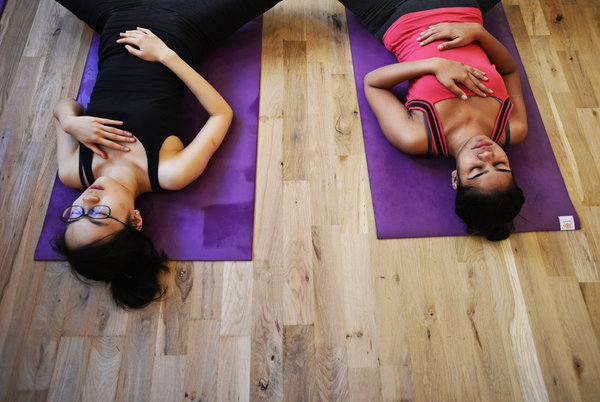1 OF 6
ALL PHOTOS
If it seems like you’re seeing more pictures of partnered-up yoga poses, it’s because you are. There are about 150,000 Instagram photos with the hashtag #partneryoga and 800,000-plus with #acroyoga, the airborne version of buddy poses. National gym chains are offering acroyoga-inspired classes like Crunch’s Acrobats Workout, which helps beginners master partner-assisted inversions. What may seem reserved for contortionists is far from it—partner yoga is about doing supported poses that deliver a deep stretch, while acroyoga focuses more on strength, gymnastics, and acrobatics.
“There are always beginners in my workshops,” says instructor Elysabeth Williamson, the author of The Pleasures and Principles of Partner Yoga. “And I’d say that 70 percent of all able-bodied people can master partner yoga.” Both are more approachable than you think. First, you don’t need to go to either class with a partner. “Most people come with a friend or a significant other, but I also encourage people to show up solo,” Williamson says. “I always have an assistant in case there’s an odd number.” (There’s built-in time to break the ice before your instructor guides you through every pose.)
With acroyoga, there are typically two roles: the flier and the base. The base lies on her back, holding up the flier with her raised legs (this can change in more advanced poses). From there, the flier moves—on the instructor’s cue—through various positions in the air, grabbing the base’s hands for support. Inspired?
Find beginner classes near you at acroyoga.org, or download Williamson’s Partner Yoga Touch app ($3.99; iTunes) to try partner poses at home. No matter which style you start with, here’s proof that the benefits extend far beyond #braggingrights.
PHOTO: @NAYITAVP
Contents
Being Present Is Easier

2 OF 6
ALL PHOTOS
You probably drift off during a five-breath triangle pose. But you have to stay focused when adding another person to your flow, because you affect their movement too. “Partner yoga fosters trust and inspires you to stay present,” Williamson says. If you zone out, your partner will lose her balance too—that’s even more likely during acroyoga. This kind of heightened presence will help you make the most of each pose and reduce your risk of injury. (If you struggle with being more mindful, try these mantrasat your next class.)
PHOTO: SHUTTERSTOCK
It Cinches Your Abs

3 OF 6
ALL PHOTOS
“In partner yoga, you’re constantly stabilizing each other’s weight, which requires your core to turn on so you can balance better,” says Anton Holmes Mackey, a yoga instructor who teaches at Wanderlust and other yoga fests. Certain poses, such as partner double plank (where two people hold a plank facing opposite directions, but one person places her feet on the other’s back), cause a deeper contraction of your transverse abdominis, taking your abs sculpting to the next level.
And with acroyoga, your entire core works to give you the stability to get into and hold poses in the air, he explains. Bases build bonus core strength too: You need to fire up your deepest abs to keep your lower back pressed firmly into the floor, and you’ll also work your obliques over time as you move your partner side to side. (Short on time? Try these quickie yoga moves that are core-focused.)
PHOTO: SHUTTERSTOCK
The Stretching Is Next Level

4 OF 6
ALL PHOTOS
Many partner poses help you boost your flexibility better than you can doing typical yoga sessions. (See partner Warrior 2, in which you pull on your partner’s wrist while facing away from each other in a long-lunge position, so you can each achieve a deeper hip stretch.) This increased flexibility can also open your practice to a new world of poses that are particularly Gumby-like.
PHOTO: SHUTTERSTOCK
You’ll Hit Your Solo Pose Goals

5 OF 6
ALL PHOTOS
Have handstand dreams? Instead of trying to swing up to stand yourself, have your partner serve as a spotter. “She’ll guide you into the proper position, which helps build up your muscle memory,” says Jessie Goldberg, the codirector of AcroYoga Montreal. “Then before you know it, you’re doing it by yourself.”
Plus, you mirror each other in partner yoga, helping improve your form and showing you what it feels like to truly master a pose, Williamson says. (Still trying to master the split? Here’s how.)
PHOTO: SHUTTERSTOCK
All the Benefits of Touch Rub Off On You

|
Pin It
|
6 OF 6
ALL PHOTOS
Touch has been shown to boost your immunity, decrease the risk of heart disease, and reduce stress. “But as a culture, we’re really lacking in touch,” Williamson says. With partner yoga, 70 percent of the class involves touch, Williamson estimates, and acroyoga is essentially all touch. (That’s just one of the reasons cuddling is so good for you too.)
PHOTO: @MELISFIT
[“source-smallbiztrends”]

